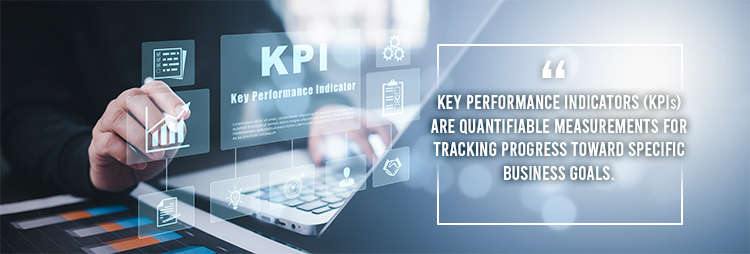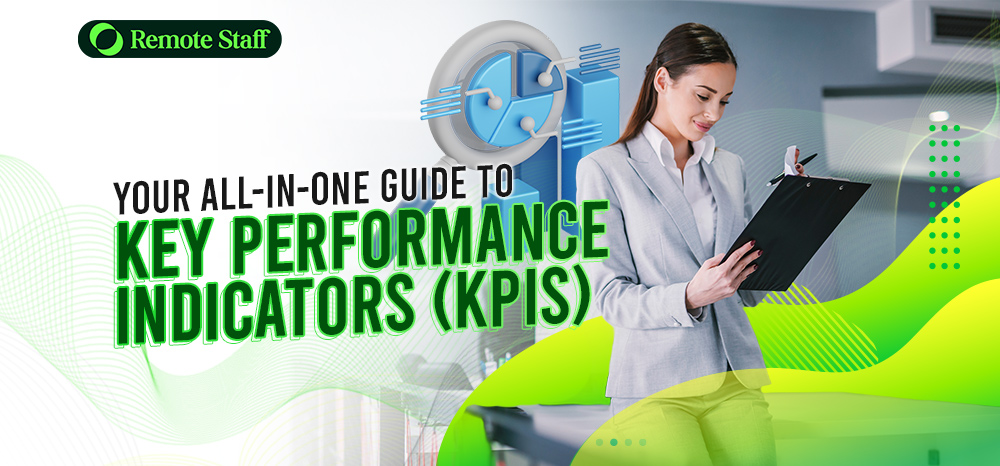Every business needs to measure its success and track its performance to achieve its strategic goals.
This is where Key Performance Indicators, also known as KPIs, come in.
KPIs help you determine which of your current business processes are on track in helping you achieve your business goals – and which ones need work.
Want to know more about KPIs, how your business can benefit from them, and how to set them yourself? Read on and find out.
What Are Key Performance Indicators?
Key Performance Indicators (KPIs) are quantifiable measurements for tracking progress toward specific business goals. These help businesses set realistic goals, measure your progress in achieving them, and identify areas for improvement.

KPIs vary between companies and industries, depending on how they measure business success.
For example, a company in customer service would use the Net Promoter Score (NPS) as its chief performance metric for gauging growth.
Aside from measuring your company’s overall performance, you can also use KPIs to assess individual team members.
For example, if you’re measuring your virtual assistant or admin assistant’s performance, your main performance measurement would be their task completion rate.
What’s the Difference Between KPIs and Metrics?
Although they’re quite similar, Key Performance Indicators and Metrics aren’t the same.
KPIs indicate how well a business meets its key objectives by measuring critical values for achieving strategic business goals.
On the other hand, metrics are any quantifiable measure used to track and assess specific business activities or processes. They provide detailed insights into your business’s operations but aren’t always tied to strategic goals.
In summary, all KPIs are metrics, but not all metrics are KPIs.
The Benefits of Using KPIs
There are many benefits to using KPIs to measure your business and team’s performance. Here are some of them:
Strategic Alignment
KPIs keep all your departments and employees aligned with your company’s overall strategic goals.

Focusing on key metrics enables businesses to steer their efforts toward common objectives for enhanced cohesion and direction.
Enables Real-Time Performance Monitoring
Regularly monitoring your team’s KPIs allows you to track their performance and identify areas for improvement.
This helps your team formulate a decisive response to sudden market changes.
Helps You Make Better Informed Decisions
Analyzing KPIs helps you better decide where to allocate resources, how to improve processes, and which strategies to pursue.
Promotes Accountability and Engagement Among Employees
With the right KPIs, employees know what is expected of them and can measure their performance according to defined standards.
This helps them better understand their role in the company and motivates them to work harder to achieve their goals.
The Limitations of KPIs
Although KPIs are invaluable tools for measuring and driving performance, it’s not without limitations:
Resource Strain
One issue with KPIs is that setting up, tracking, and analyzing them can be time-consuming and resource-intensive.
It requires constant monitoring to yield accurate and useful results and you may need to hire specialized staff to handle KPI tracking and analysis.
Poorly Made KPIs Lead to Misalignment With Strategic Goals
If you don’t select the right KPIs, you may end up chasing goals that don’t contribute to your company’s strategic objectives.

This leads to wasted efforts or misguidedly prioritizing short-term goals over long-term ones.
Potential for Abuse
Some managers tend to focus on KPIs connected to performance bonuses instead of those that boost processes or results.
This causes them to manipulate their actions or processes to meet KPIs without improving the overall performance or achieving their true goals.
At worst, this leads to employees and managers deliberately altering or skewing their performance data to match KPI targets.
KPIs May Lead to an Overemphasis on Quantitative Data
A business’s overreliance on KPIs often leads to them forgetting about equally important quantitative data like employee morale and customer satisfaction.
How to Set Good KPIs
With so much data available today, it can be difficult to determine which metrics have the most impact on your business.
When developing KPIs, here are some steps you must follow:
- Identify your key objectives: Before developing KPIs, you must first determine what your business wants to achieve. Doing so helps you ensure your KPIs reflect these objectives and establish a clear path to measure progress.
- Draft SMART KPI requirements: After identifying your strategic goals, it’s time to select KPIs relevant to them using the SMART formula (Specific, Measurable, Attainable, Realistic, and Time-bound).
- Communicate your KPIs clearly: Once you’ve set your KPIs, make sure you can justify the significance of each one. When they do, they can better align their efforts towards achieving their assigned goals.
- Regularly monitor and review your progress: Use data analytics tools to help you track your progress toward achieving your KPIs. Schedule regular reviews to identify trends, make adjustments, and ensure your strategies remain effective.
- Avoid KPI overload: Keep the number of your KPIs small by focusing on the most important goals.
- Use KPIs for Continuous Improvement: Gather feedback from your team and be prepared to adjust or revise your strategies as needed to meet your business objectives.
Common Types of KPIs
Here are some of the most common KPIs you’ll encounter per industry:
Sales KPIs
These KPIs track the performance of your company’s sales. These include:
- Monthly sales growth
- Average conversion time
- Customer lifetime value
- Customer acquisition cost
- Number of engaged leads in the sales funnel
Financial KPIs
Financial KPIs measure your company’s financial performance and health. These include:
- Revenue growth
- Net profit margin
- Turnover ratio
- Return on investment (ROI)
- Profitability ratios
Customer KPIs
These KPIs measure customer satisfaction, loyalty, and retention. These include:
- Customer satisfaction rating
- Net promoter score
- Customer retention rate
- Average resolution time
- Average response time
Marketing KPIs
Marketing KPIs measure the effectiveness of your company’s marketing efforts in reaching and engaging your target audience. These include:
- Monthly website traffic
- Page likes and comments
- Conversion rate
- Blog articles published per month
- Click-through rate percentage
Employee KPIs
These measure aspects of employee performance, satisfaction, and engagement. Employee KPIs include the following:
- Employee satisfaction
- Employee turnover rate
- Number of applicants
- Number of overtime hours worked
- Absenteeism rate
KPI Categories
KPIs can also be divided into categories based on their focus and the business aspects they measure. Here are the four main categories of KPIs:
Strategic KPIs
Used mainly by executives, these monitor your business’s organizational goals, although it doesn’t provide much information beyond that. Typically, an executive would look at one or two strategic KPIs to determine how the company is doing at any given time.
Operational KPIs
Operational KPIs measure the efficiency and effectiveness of a company’s daily internal processes. Managers refer to these when analyzing strategic KPIs.
Functional KPIs
These KPIs are specific to individual departments or functions within a company such as marketing, IT, sales, etc.
For example, the Marketing department usually tracks the monthly traffic of the company’s website, while the financial department tracks the company’s net profit margin.
Leading/Lagging KPIs
Leading and lagging KPIs are categorized based on their timing and predictive nature, the former predicts future performances while the latter analyzes past performances.
Hit Your Business Goals With the Right KPIs
Key Performance Indicators are a vital tool for helping you track and measure your company’s performance.
This way, you can make better-informed decisions to grow your business and adapt to today’s ever-changing business landscape.
Are you looking to improve your performance by outsourcing to the Philippines? Click here to see our full list of candidates.
Besides virtual assistants, we also have candidates for accountants, which is perfect if you’re feeling the pinch from the accountant shortage and need to outsource your accounting needs. Good luck!
John Carlo Pagsolingan is a carefree yet hardworking writer with aspirations of becoming a teacher in the future. He believes that remote working isn’t just a substitute; but is a legitimate alternative to face-to-face work. Learn more as he writes about the advantages of remote work and tips for aspiring remote workers.





















